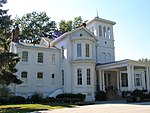USS Forrest Sherman (DD-931)
1955 shipsCold War destroyers of the United StatesForrest Sherman-class destroyersShips built in Bath, MaineVietnam War destroyers of the United States

USS Forrest Sherman (DD-931) was the lead ship of her class of destroyer of the United States Navy. She was named for Admiral Forrest Sherman USN (1896–1951).
Excerpt from the Wikipedia article USS Forrest Sherman (DD-931) (License: CC BY-SA 3.0, Authors, Images).USS Forrest Sherman (DD-931)
Constitution Avenue, Philadelphia South Philadelphia
Geographical coordinates (GPS) Address Nearby Places Show on map
Geographical coordinates (GPS)
| Latitude | Longitude |
|---|---|
| N 39.893055555556 ° | E -75.188888888889 ° |
Address
Building 646
Constitution Avenue
19112 Philadelphia, South Philadelphia
Pennsylvania, United States
Open on Google Maps









